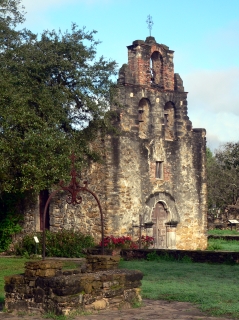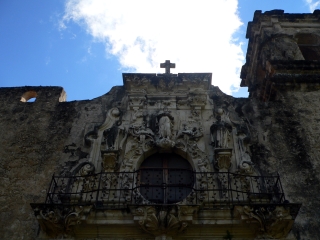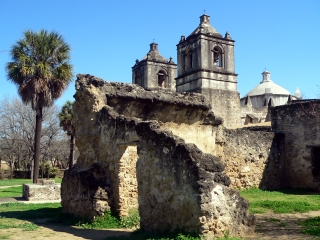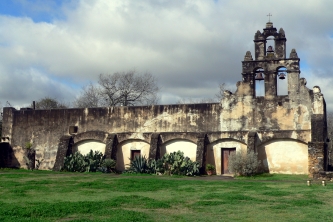NPS Website; Local Website; Alamo Website

WHAT IS IT?
Four of the five 18th Century Spanish missions that served as the foundation for the city of San Antonio and for the spread of Spanish life and Catholicism in the western portion of the New World. The fifth and northernmost Spanish mission, San Antonio de Valero, is not a part of the National Park Service. It is run by the Daughters of the Republic of Texas and more commonly known as the Alamo.
BEAUTY (8/10)
We have all seen the pictures. White limestone bell towers setting off an impossibly blue sky. Spanish crosses silhouetted against sunsets the color of blood oranges. Ornate wooden doors with yucca and cacti as sentries. These are the pictures most of us conjure when we think about the Southwest. We wanted those pictures.
It took a few days of trying, but we think, we hope, we were able to capture some of that beauty. Each of the four Mission churches is built in a typical Spanish Colonial style, yet each are infused with their own personality, shaped by those who built them.
Mission San José houses la Ventana de Rosa, which may or may not be named after a craftsman’s true love lost at sea en route to San José. The window is said to be the premier example of Spanish Colonial ornamentation in the New World. San José is the largest of the Missions and was considered a model community. It bears its title of “Queen of the Missions” proudly.
Mission Concepción still offers visitors patches of its brightly colored walls. Bold geometric patterns have faded but some interior rooms show religious symbols mixed with decorative shapes.
Mission San Juan still bears its original wood door. There was time to peek into San Juan before Sunday services began. Stark, except for the graphic imagery of the dying Jesus, we could understand why some Indians were hesitant to convert to this new faith.
The Church at Mission Espada is technically incomplete. Plans to enlarge the church were postponed when the master artisan abruptly left the mission taking his designs with him. His journeymen and apprentices were left to patch together a smaller version, which may explain the strangely shaped stone archway over the main entrance.
 HISTORICAL INTEREST (7/10)
HISTORICAL INTEREST (7/10)The San Antonio Missions were one of Spain’s most successful forays into New World settlement and mark the clear beginning of both the City of San Antonio and the State of Texas.
17th Century Spain attempts to colonize the American west varied from the English models in the East. The Spanish had few people to spare as colonists and wanted to ensure that the Kingdom was devoutly Catholic and theirs. The French threatened to expand into Spain’s western territories. Spain’s solution was to build missions and convert the native Indian population to loyal Catholic subjects of the Spanish crown.
The missions were self-sustaining communities based on strict social, moral and religious discipline. The San Antonio Missions flourished because hostile tribes from the North terrorized the local Indians, the hunting and gathering Coahuiltecan. The Spanish missions provided them sanctuary and defense. As time passed, the Indian and Spanish cultures became one.
The Missions were secularized in 1824 when Spain left the New World. The City of San Antonio grew from this base. In 1836, Santa Anna’s bloody siege immortalized the San Antonio de Valero Mission. The massacre at the Alamo became a rallying cry for Sam Houston’s Texas army who would defeat Santa Anna a month later at San Jacinto and claim their independence.
CROWDS (8/10)
All four Missions remain active parishes. They were alive with activity on the Sunday of our visit.
Despite their proximity to a major urban center, the southern two Missions, Espada and San Juan, still feel isolated and rural. Only Mission San José brings a large tourist crowd. Its grounds are ample and there is never a feeling of visitor claustrophobia; unlike the mood downtown near the Alamo where you feel like herded cattle.
EASE OF USE/ACCESS (5/5)
The southern-most mission, Mission Espada is located halfway between Exits 42 and 44 of the San Antonio Beltway, Interstate 410. It is at about the 5 o’clock point on the beltway’s circle. From there the well-marked Mission Trail winds northward up the San Antonio River to Mission San Juan and then Mission San José, the location of the Park’s Main Visitor Center. The Park Service’s northernmost mission is Mission Concepción.
The distance from Espada to Concepción is only about 5 miles. If you continue north for about 2 more miles you will reach San Antonio’s City Center and the Alamo. There should be enough parking at the NPS sites unless you go on Sunday. The missions are still active parishes and the church services fill the lots, especially at Mission Concepción.
Parking at the Alamo can be pricey and will be much more difficult.
CONCESSIONS/BOOKSTORE (5/5)
 The bookstore located at the Mission San José Visitor Center has stacks and stacks of books about the area’s history and culture. Here are a few of the more intriguing titles: Origins of New Mexico Families: A Genealogy of the Spanish Colonial Period; Bricks Without Straw: A Comprehensive History of African Americans in Texas; Chilies to Chocolate: Food the Americas Gave the World; and Mexican Tiles: Color, Style, Design.
The bookstore located at the Mission San José Visitor Center has stacks and stacks of books about the area’s history and culture. Here are a few of the more intriguing titles: Origins of New Mexico Families: A Genealogy of the Spanish Colonial Period; Bricks Without Straw: A Comprehensive History of African Americans in Texas; Chilies to Chocolate: Food the Americas Gave the World; and Mexican Tiles: Color, Style, Design.There are hardcover tomes dedicated to the Conquistadores, and sections on Mexican Folklore, Tejano culture and Comanche Indians. A few titles are in Spanish. The bookstore sells a Spanish-English dictionary if you need help with a few words.
We also liked the posters emblazoned with chile peppers and a southwestern kitchen.
COSTS (5/5)
Entrance is free. There are anywhere from 10-14 free Ranger-led guided tours given at the Missions every day.
RANGER/GUIDE TO TOURIST RATIO (4/5)
San José, by far the most visited of the missions, was adequately staffed with no less than five Rangers. Ranger-led talks and tours are regular and frequent. When we asked about tours in the other missions, a portly Ranger laughed. They’ll be so happy to talk to you; you won’t be able to leave. Two Rangers did fill our ears at Mission Espada but we were willing receptacles. Rangers at Mission Concepción and San Juan were a little harder to find,
TOURS/CLASSES (6/10)
In addition to Ranger-led activities, an “award winning” film entitled Gente de Razon is shown at the San José Visitors Center every half hour. We didn’t much care for it but we were the minority. Other audience members oohed and ahhed the well-produced video which seeks the spirits of lost Native American cultures in the walls of the missions.
There are small museums at each Mission, each focused on a different aspect of the Spanish Colonial Period. The electronic map at San José is broken.
San José, the “Queen of the Missions”, is the most visitor friendly of the four sites. Exhibits line the Granary and a Spanish Colonial bookstore and a religious gift shop fit nicely into the outer walls of the mission. San José’s Grist Mill has been completed restored; a volunteer was demonstrating the milling process as we walked through.
We enjoyed walking the grounds of each mission. Church was in session during our visit. What we missed seeing the interiors of the churches, we gained in atmosphere. On this beautiful spring morning, it was easy to see the San Antonio Missions aren’t relics from a forgotten age; they are vibrant centerpieces of Tejano culture.
FUN (6/10)
Our first trip to Mission San José was shrouded with grey clouds, not very camera-friendly. We decided to watch the film and come back the following day. Of course, it rained and rained and rained. Still hoping for some decent photographs, we delayed our visit yet again. This time it was a Sunday morning, the sun was shining and we made it to Mission Espada before the Rangers even opened the doors.
We spent the next four hours traveling north along the Mission Trail towards San Antonio, hoping to cap off our delightful day with a stop at the Alamo and lunch along the city’s famed Riverwalk. The closer we got to the city, the more we wished we had spent more time on the dewy lawns of Espada and San Juan. Parking was tight at Concepción and nearly impossible near the Alamo. By the time we took our place in line to reverentially stare at something we can’t remember because photos aren’t allowed, we were darn near frazzled.
The Alamo is overrated and a lot smaller than you would imagine.
 WOULD WE RECOMMEND? (8/10)
WOULD WE RECOMMEND? (8/10)While the Alamo is overrated, its four NPS counterparts are not. All of the Missions within the San Antonio NHP preserve the memory of not one event, but of a series of events which transformed the lives and identities of thousands of Native Americans and shaped the look and feel of present day San Antonio and large portions of the American Southwest. Go see the Alamo but spend the day among the lesser known Missions and understand the origin of a culture that is now neither Spanish nor Indian, but both.
TOTAL 62/80
www.usa-c2c.com
© 2004-06